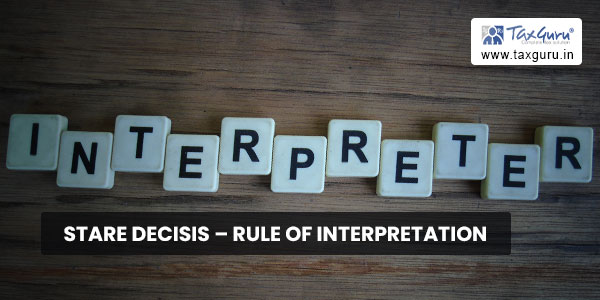Stare decisis is also known as the concept of precedent, which means the decision taken by the higher courts shall be followed/binding on the lower courts, which stands as a precedent to the lower courts. This gives the law finality and maintains consistency and permanence.
Principle settled, accepted, and acted upon for a long should not be easily departed from. While departing from the settled law or practice, the courts cannot ignore the harm that is likely to happen by unsettling the law that has been settled.
This principle was initially coined in medieval England and America, where the courts looked into the judgment of earlier cases as guidance also had the power to reject those which they do not consider good or which they considered bad in their judgment.
Article 141 of the Indian Constitution states that “Any law declared by Supreme Court to be binding on all courts within the territory of India.” Therefore, while applying the decision of S.C. by other courts, what is required is to understand the right principle laid down by the previous decision.

The Supreme Court referring to Muktul vs. Manbhari, AIR 1958 SC 918; and relying upon the observations of the Apex Court in Mishri Lal vs. Dhirendra Nath (1999) 4 SCC 11, observed in Union of India vs. Azadi Bachao Andolan (2003) 263 ITR at 726: “A decision which has been followed for a long period of time, and has been acted upon by persons in the formation of contracts or in the disposition of their property, or in the general conduct of affairs, or in legal proceedings or in other ways, will generally be followed by courts of higher authority other than the court establishing the rule, even though the court before whom the matter arises afterward might be of a different view.”
Following the Precedents has its own advantages and disadvantages too, here are some of those advantages and disadvantages:
Advantages of Stare Decisis:
- It brought certainty and consistency in the law. A good decision-making body needs to have consistency and avoid arbitrariness in its judgments.
- There is an orderly development of the law.
- It eliminates the element of ambiguity and enables the lower courts to follow the decision of the higher court unanimously and without question.
Disadvantages of Stare Decisis:
- The first and foremost disadvantage of this doctrine and the precedent system is its rigidity and unwillingness to allow change.
- Practical law is based on experience, by considering precedent the scope of experience decreases which hampers the essence of practicing law
- Sometimes judicial decisions may be wrong and the same mistake is being continued in the form of precedent law.






One of the major for ‘Stare decisis’ is not applicable to AAR orders issued which means AAR has the liberty to give no reasons why the previous settled decision was not followed even when referred by the applicant
Stare decisis – Principles of Stare decisis is a principle of law that has a binding force on lower courts and should be followed in similar cases, it gives certainty to law and guides people to their affairs accordingly